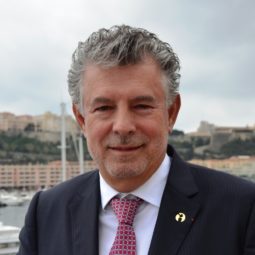What is the priority of sport for peace in 2018? Should we focus on teaching, so that sport can create social change at schools and universities around the world? Should we promote sport for peace as a top priority for policy makers and governments? Should we encourage more athletes to join the cause and advocate for peace, human rights and inclusion? Finally, should we invest more into sport-based initiatives in crisis-torn areas? These questions need to be considered on a daily basis. Only then can we appreciate that this year of 2018 is, and must be seen as, a year of opportunity for targeted action on various fronts and levels, using a holistic approach.
Building peace and transcending local, regional and global conflicts cannot be left entirely to the hands of political leaders. What is necessary herewith is not only political governance, but to find spaces and platforms that bring people together under a common goal. Moreover, what we need are leaders and key actors that seize the moment. What does it mean for a leader to seize the moment? It means to be keenly aware of her/his social, economic and cultural context, and to see opportunities where others do not.
In this light, 2018 offers a multitude of opportunities to promote social change and to create the conditions for sustainable peace through sport. PyeongChang 2018 Olympics and the 2018 FIFA World Cup can be used as platforms to reduce tensions between states at odds and promote diplomacy.
Amid escalating tensions over North Korea’s nuclear weapons program, and after the United Nations and United States stepped up their extensive sanctions against North Korea, the Winter Olympics can help to demonstrate sport’s special capacity to open doors and foster dialogue. In the past, Peace and Sport have seen the willingness from North and South Korea to use sport to build bridges. At the end of 2011, Peace and Sport in cooperation with the International Table Tennis Federation (ITTF) held a Table Tennis Cup in Doha, Qatar. North and South Korea were among the countries participating in this international tournament. Over two days, dozens of players from different countries played in mixed teams. South Koreans played alongside North Koreans, on the same side of the table. They won together, and sometimes they lost together.
A further, more recent, example took place in 2017. Last year, Peace and Sport in cooperation with the International Ice Hockey Federation (IIHF) gathered athletes from both North and South Korea to pose together for a #WhiteCard picture following their match at the Women’s World Ice Hockey Championship during the PyeongChang 2018 Ice Hockey Test Event.
The ice hockey #WhiteCard picture is a considerable achievement for Peace and Sport’s campaign, following the latest developments in the international relations between North and South Korea. Recently, South Korea announced that is looking into the possibility of a shared women’s ice hockey team with North Korea at the 2018 Winter Olympics.
While some political leaders have started 2018 inciting division, racism and xenophobia, athletes and the sport industry can seize the opportunity presented during key sporting events to send a clear message that humanity should not be eroded. This year, athletes, international and national sport federations, universities, governments and civil society should use South Korea and Russia as epicenters of social change and seedbeds for social innovation.
In that sense, it is important that this year the sport for development and peace movement work together facilitating and engaging in stronger partnerships and sport-based initiatives. For example, the International Day of Sport for Development and Peace (IDSDP) celebrated on April 6 is a good moment to mobilize communities and actors around a common vision and promote concerted action. As for business, it is important that they join the cause and commit to making a positive impact on society. It doesn’t have to be only about donating money. It can also be through social business.
One must work on making sport accessible for all. Sport Simple Solutions, a concept that sees sport venues, equipment and rules adapted to accommodate limited resources or harsh environments, offer a great opportunity to bring sport to the most vulnerable areas.
We will soon witness the Olympics feeling that inspire us to keep working on peace. I believe that an outstretched hand from one participant to another represents even more effort towards peace than countless political speeches. It would be a great example seeing athletes from Palestine and Israel or Armenia and Azerbaijan hold hands in a competition.
The values of sport cannot alone resolve each problem, but these values offer a voice to athletes, associations and governments to advance peace. More than ever, it is time to create new opportunities for peace. It is through looking for opportunities and curiosity that we will be able to map more inclusive and tolerant societies.
